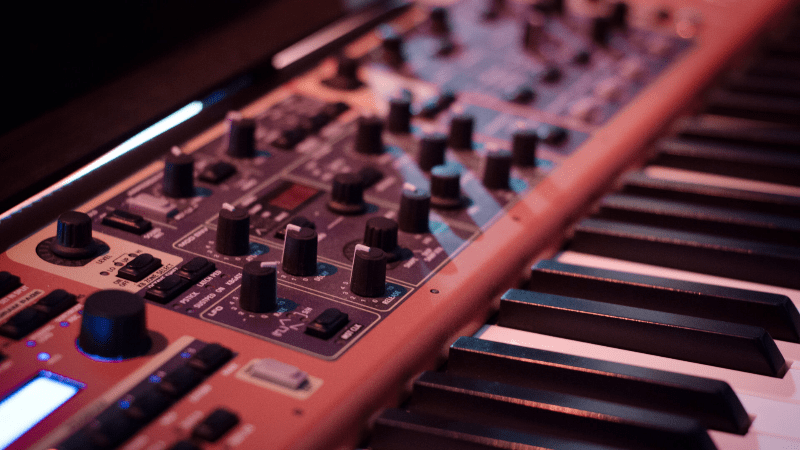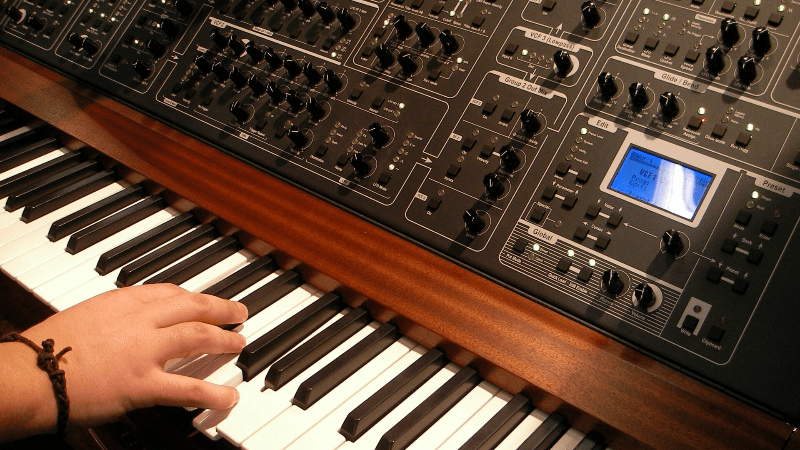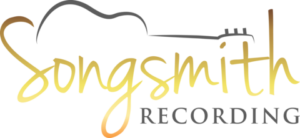
Like many people, I’m trying to learn new things, including how to use a synthesizer. Although I’m used to digital synths, I haven’t used physical ones much. So, I decided to learn more about them. I decided to include everything into an easy to follow useful analog synthesizer essentials starters guide, and share that here.
As I’ve started exploring synthesizers again, I’ve realized that they aren’t as scary as I thought. Getting a synthesizer and learning how to use it isn’t as hard as you might think.
Learning how to operate a musical synthesizer shouldn’t be challenging, even for beginners. There are plenty of accessible resources that break down the signal flow of synthesizers, providing a quick overview to dispel any intimidation. The multitude of knobs and buttons aren’t meant to be daunting; they’re tools for freely carving and shaping tones.
Sometimes, all we need is a little push in the direction we already want to go. So, consider this your push towards exploring synthesizers. Whether it’s just a hobby or something more, feel free to dive in.
To begin, take a look at this summary I’ve put together about what I’ve learned while researching “synthesizers for beginners.” Once you’ve read it, you’ll have a good idea of what your next step should be in exploring this interest.
1. You Are Allowed And Encouraged To Explore Every Button And Knob
Exploring the buttons and knobs of a synthesizer, twisting and turning them to your heart’s content, is where the real fun begins! There are no strict rules about what you should or shouldn’t do. Sure, understanding some basics about how it works can enhance your experience, but you don’t need to know everything right away.
Giving yourself permission to play around with the gear, any gear, takes away the intimidation factor. Remember, while there may be lots of buttons and circuits, and while there’s a learning curve to understand audio sound and synthesizers better, it’s not rocket science.
2. There Are Plentiful Resources Available Online To Help
There are plenty of online sources and resources available to help you get familiar with synthesizers. You can find YouTube videos, blogs, forums, and vendor websites that demonstrate how to navigate specific keyboards’ signal flow. They also offer recommendations on which keyboards are suitable for beginners and what sets them apart.
Once you leave here, you can start exploring your options and see which ones catch your interest. When you’ve decided on a synthesizer to start with, you’ll find plenty of free advice from YouTube influencers. They will help you know how to get started with that particular model. You’ll also find more in-depth videos introducing you to the parameters and functionality of the synthesizer you’re working with.
So, rest assured that it’s relatively easy to find guidance on other useful analog synthesizer essentials
3. There Are Easy To Understand Simple Basics
Like with anything else, it’s best not to jump straight into the deep end, especially if there’s no emergency pushing you to do so. Take your time and make gradual progress each day. Eventually, you’ll accumulate a solid foundation of knowledge and become more experienced and familiar with synthesizers.
For now, here are some basics to help you get started. Firstly, synthesizers come in two main types: digital and analog. Analog synths use analog circuitry to create and manipulate sounds physically, while digital synths use computer processors and algorithms to mimic what analog synths do naturally.
Your first decision will be to choose which type you want to start with. At this stage, there’s no wrong answer, so go with whatever appeals to you. If you’ve looked into recommendations for beginner-friendly synths and found a video that resonates with you, then pick the one that interests you the most. Sometimes, following your instincts is enough to guide you to the next step.
Later on, as you progress, you can always sell your starter synth and upgrade to something more advanced. So don’t spend too much time worrying about making the wrong choice—just choose the quickest path that gets you started.
4. There Is Technical Terminology; But There Are No Tests
You don’t need to worry too much about learning all the details of synthesis, especially at the beginning.
One of the most intimidating things about synthesis is the new terminology. Words like “Monophonic” and “Polyphonic” might sound strange at first, unlike everyday words like “TV” or “Pizza.” But don’t worry, there are only a few of these terms to learn, and once you understand the basics, everything will start to make sense, and the new vocabulary will become familiar.
So, what is “Polyphony”? It simply refers to how many keys can be pressed down at the same time on a synthesizer, and each produces a sound. It implies more than one.
A “Monophonic” synthesizer, on the other hand, can only produce one sound at a time. It might sound simple, but there’s a cool effect called morphing that happens when the synth changes between notes. You’ve probably heard this effect in popular music before—it’s a desirable sound that adds depth to the music.
Polyphonic
A Polyphonic synthesizer can produce multiple tones simultaneously. Each synth has its own capacity of polyphonic voices, like 4-voice or 8-voice, indicating how many notes it can play at once.
Don’t feel intimidated by not knowing which is best for you. Just take the next step and explore some comparison videos online of beginner-friendly synths. You’ll gain insight into which one suits you best.
When it comes to all this new terminology, remember it’s just a way to share information. And the good news is, we’ve already learned a few new synth-related words without much difficulty. So, congratulations! You’re not quite the beginner you were before we started. Great job!
5. All The Simple Basics Are Universal To All Synths

Once you understand the basics of synthesis, that knowledge stays with you. The simple fundamentals carry over from one synth to the next.
Some people just want to play music without worrying about sound design or programming. For them, a keyboard with cool presets available out of the box is perfect. Presets are premade sounds stored in the keyboard.
But if you’re interested in creating your own unique tones and sounds, you’ll need a synth that lets you make your own customized presets. Understanding how a synthesizer works will help you grasp what’s happening inside and what you’re manipulating to create the sound. It’ll also help you learn the vocabulary of synthesis.
In an analog synth, sound is produced by what’s called an oscillator. A synth usually has a few oscillators, each producing sound. You’ll manipulate them by adjusting frequency or filter settings, and then blend them together to create a playable tone on the synth’s keyboard.
The First Step
The first step in shaping sounds on the synth involves deciding what type of sound wave each oscillator will produce. You can choose from options like Saw, Triangle, or Square waves.
These different wave types might not make sense to you right now, but don’t worry—it’ll all click once you’ve watched some videos and heard them for yourself. For now, understand that you’ll pick one wave type for each oscillator. Then, in the next step, you’ll adjust the sound created by the oscillator using filters and EQs. Throughout this process, you’ll blend them together to create a fully customized sound that’s unique to you.
As you can see, once you grasp the basics, it all becomes less mysterious. It’s really just about experimenting until you’ve sculpted something you find interesting and want to save in the program storage banks.
6. Every Synth Has A Logical Workflow
While each synthesizer may have unique characteristics, you’ll find that all synths are designed with intuitive and logical controls. Whether it’s arranged from top to bottom or side-to-side, creating a sound on one synth is as straightforward as moving across its surface, with each knob and button leading to the next. That is one of the useful analog synthesizer essentials to keep in mind.
Once you’ve set up your oscillators and chosen the sound wave for each, you’ll move on to blending their sounds together by adjusting their volume.
Next, you might come across the Portamento control, which affects how one note slides into the next. It’s like morphing from one note to another. Adjusting Portamento changes the speed of this morphing effect. Turn it up for a dramatic shift between notes, or down for a smoother transition, similar to an ordinary piano.
After tweaking Portamento to your liking, you might encounter a Cutoff filter. This filter reduces high frequencies. Adjust it until you’re satisfied with the sound.
A Few More Sections
After adjusting the volume and cutoff filter, you’ll come across another important section called the Envelope. This tool affects how we hear the sound and has four primary variables: Attack, Decay, Sustain, and Release.
The Attack parameter determines how quickly the sound fades in. You can adjust it from an instant fade to a gradual one.
Decay defines how long it takes for the sound to fade from its maximum level at the Attack to the Sustain level. It can be immediate or gradual.
Sustain sets the level of the sound after the initial Attack and Decay. It’s constant for as long as the key is pressed, whether it’s for a short time or an extended period.
determines how long it takes for the sound to fade out after the key is released.
Some synths also feature a built-in sequencer, which allows you to step-record parts. You create a loop, record your part, and then add additional layers on top of it. Step recording means moving from one step to the next in the sequence.
7. One Synth’s Workflow Is Relatable To Another’s
I’ve included this as one of the useful analog synthesizer essentials. I think its important to emphasize the value of the knowledge you’ll gain as you progress. Once you understand how to navigate the interface of the synth you start with, you’ll find that it’s applicable to every other synth you encounter.
In other words, the basic understanding you’ll develop to operate your own synth, followed by mastering it, will not only enable you to proficiently use that one synth but also give you the skills to explore any synth effectively.
Take your time and explore as many how-to forums related to your specific synth as possible. Set aside time to watch one or two demonstration videos each day for a week or two. You may find it’s more than necessary, but starting in that direction will help you become competent enough to know when tutorials are no longer needed.
8. You Don’t Need To Be A Skilled Musician

Not being a skilled pianist shouldn’t stop you from getting into synthesis. It’s important to understand the different motivations people have for getting into it. Some may be interested in creating and shaping sounds, while others may be keyboardists looking for an analog synth for live performances.
If you’re just starting out and don’t know how to play, don’t worry. A good place to start is by learning scales and practicing scale exercises. This will help you play basic leads on the synth.
Keep in mind that a monophonic synth can only play one note at a time, and even a polyphonic synth has limits on how many notes you can play simultaneously. Learning basic scales is the best starting point. If you’re using a polyphonic synth, learning basic chords would also be helpful.
But don’t let your lack of advanced playing skills hold you back from getting started. There’s plenty you can do with synthesizers, such as sculpting and shaping sounds, without needing to play at an advanced level. So, don’t let unnecessary obstacles get in the way of your interest and potential.
9. Basic Mastery Unleashes A Powerful Tool For Expression
It doesn’t take a long time to understand how to navigate the various parameters of a synthesizer or to reach a reasonable level of proficiency with using one especially when you start with useful analog synthesizer essentials. Once you’ve reached that point, the possibilities are endless. You can create as many patches as you like and work on refining your skills, building towards your own potential as regularly as your schedule permits. So, don’t hesitate to dive in and start exploring the world of synthesis!
10. Free Software Synths To Try Before You Buy
Buying new gear is a significant investment, but there are various ways to start your journey into electronic synthesis. If you’re certain about purchasing a specific brand-new synth, that’s great. I’d recommend visiting a big box music store to try out the synth in person and get a feel for it before making a decision. The store clerks can also help walk you through some basic functions and parameters to make an informed purchase.
If you’re open to buying second-hand gear, you’re in a good position. You can search for demonstrations of suitable synths for beginners online and then start shopping for a second-hand synth that fits your needs. Here is a link to a guide about what you need to think about when and how to source buying second hand gear. It should help!
Alternatively, you can download a few free synths to your computer, smartphone, or tablet. This allows you to interface with virtual synths and gain a deeper understanding of how they work without spending any money. As your passion for synthesis grows, you’ll be more confident in selecting a piece of gear that you’d really like to own, whether it’s new or second-hand.
11. There Are No Rules
The beauty of these useful analog synthesizer essentials is the freedom they offer. While each parameter may have its limits, there are no rules dictating what a sound should ultimately sound like. You can build any preset you like, sculpting the sound in any way you find useful. Even if others perceive a sound as horrible, that same patch could be perfect for a horror movie soundtrack. So, there are limitless possibilities and no right or wrong choices. It’s an opportunity for you to create to your heart’s content, and that’s exactly what you should do.
In Conclusion
I hope these useful analog synthesizer essentials have been helpful to you. Life is too short not to explore the things you’re interested in, and when it comes to synthesizers, don’t let the intimidating knobs and buttons hold you back. Your lack of musical background shouldn’t discourage you either.
I’ve covered some basic parameters of synthesizers and spent the rest of the time trying to reassure you that diving into synthesis is something worth doing if you want to. From here, go ahead and explore some demos, maybe even download a synth on your computer to follow along with. The world of synthesis is waiting for you to discover it!
Now go and get to it.
Good luck!
